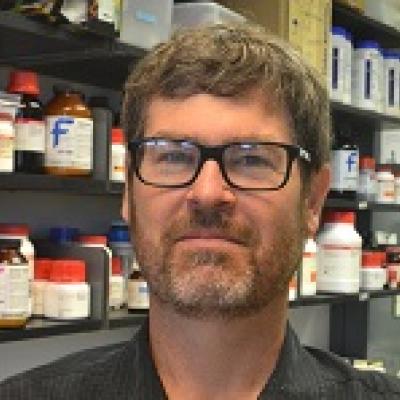Robert Sabatini

Research
Among the parasites we currently study in the laboratory are African trypanosomes, unicellular eukaryotic protozoa that infect the bloodstream of mammals to cause sleeping sickness in equatorial Africa. Trypanosomiasis continues to be a daily threat to more than 60 million people in 36 countries of sub-Saharan Africa. It is estimated that approximately 300-500,000 people have the disease. While they reside in the mammalian bloodstream, the trypanosomes are able to evade the host’s immune response by regularly changing their variant surface glycoprotein (VSG) coat, a process called antigenic variation. By changing its VSG coat the trypanosome is able to change its identity and is no longer able to be recognized by the current wave of antibodies produced during the host immune response. In this way the trypanosome population is able to remain a step ahead of the host immune system. This evasion strategy allows the long-term survival of these parasitic organisms within the host and has frustrated all attempts to develop a vaccine. One of the main research goals in this laboratory is to understand how the trypanosome is able to escape the host immune system allowing the parasite to proliferate in the mammalian bloodstream and eventually cause disease.
To switch its surface coat the trypanosome can select any VSG from a large family of VSGs. Each trypanosome contains ~1,000 VSG genes but expresses only one at a time. The VSG that is expressed is always found near the end of a chromosome, within what is called a telomeric VSG expression site (ES). The remaining majority of VSG genes are distributed internally throughout the chromosome. VSG switching is accomplished primarily by recombination of a new VSG gene into the active ES or by simply switching the telomeric expression site that is being transcribed.
Future goals: Biosynthesis and Function of Base J
The current research focus of the lab concerns on the function of a novel modified DNA base, called base J, on the regulation of VSG gene expression. This modified base represents a specific modification of thymine residues where a large glucose moiety is covalently attached to the base and extends into the major groove of the DNA helix. This glycosylated base is unique to the family of kinetoplastidae and is not found in the DNA of multicellular organisms such as their mammalian hosts. In trypanosomes, the synthesis of base J correlates with the regulation of antigenic variation and primarily replaces thymine residues in repetitive DNA sequences flanking, as well as within, the telomeric VSG expression sites. We have recently deleted the genes for the two thymine-hydroxylases involved in J-biosynthesis from the bloodstream form trypanosome. These J-null trypanosomes completely lack base J and undergo rapid VSG gene switching. Our working hypothesis is that the absence of base J de-stabilizes the sub-telomeric repeats involved in homologous recombination based VSG switching.
1. Characterize the thymine hydroxylases involved in J-synthesis: why are there two?
2. Identify the glucosyl-transferase involved in J synthesis.
3. What determines the specific localization of base J sythesis in the genome?
4. How does base J regulate telomeric homologous recombination?
5. Elucidate the function of base J in telomeres of other kinetoplastids (T. cruzi)?
Selected Publications
- Cross, M., R. Kieft, R. Sabatini, M. Wilm, M. de Kort,G. A. van der Marel, J. H. van Boom, F. van Leeuwen and P. Borst. 1999 The Modified Base J is the Target for a Novel DNA-Binding Protein in Kinetoplastid Protozoans. EMBO J., 18: 6573-6581
- Sabatini, R., N. Meeuwenoord, J.H. van Boom and P. Borst. 2002. Recognition of Base J in Duplex DNA by J-binding Protein. J. Biol. Chem., 277: 958-966
- Sabatini, R., N. Meeuwenoord, J.H. van Boom and P. Borst. 2002. Site-specific Interactions of JBP with Base and Sugar Moieties in Duplex J-DNA. J. Biol. Chem., 277: 28150-28156.
- Cross, M., R. Kieft, Sabatini, R., A. Dirks-Mulder, I. Chaves and P. Borst. 2002. J-Binding Protein Increases the Level and Retention of the Unusual Base J in Trypanosome DNA. Mol. Micro., 46: 37-47.
- DiPaulo, C., R. Kieft, M. Cross and R., Sabatini. 2005. Regulation of Trypanosome DNA Glycosylation by a SWI2/SNF2-like Protein. Mol. Cell, 17: 441-451.
- Toaldo C.B., R. Kieft, A. Dirks-Mulder, R. Sabatini, H.G.A.M. van Luenen and P. Borst. 2005. A Minor Fraction of Base J in Kinetoplastid Nuclear DNA is Bound by the J-Binding Protein 1. Mol. Biochem. Parasitol, 143: 111-115.
- Yu, Z., Genest, P.A., Riet, B., Sweeney, S., DiPaulo, C., Kieft, R., Christodoulou, E., Perrakis, A., Simmons, J., Hausinger, R.P., Luenen, H., Rigden, D., Sabatini, R. and Borst, P. 2007. The protein that binds to DNA base J in trypanosomatids has features of a thymidine hydroxylase. NAR, 35: 2107-2115
- Brand, V., Kieft, R., Sweeney, K., Ekanayake, D.K., DiPaulo, C. and Sabatini, R. 2007. JBP2, a SWI/SNF2-like Protein, Regulates De-novo Telomeric DNA Glycosylation in Bloodstream Form Trypanosoma brucei.
- Ekanayake, D.K., Cipriano, M. and Sabatini, R. 2007. Telomeric Localization of the Modified Base J and Contingency Genes in the Genome of the Protozoan Parasite Trypanosoma cruzi.

Department of Biochemistry and Molecular Biology
rsabatini@bmb.uga.edu
Office:
A426A Life Sciences
706-542-9806
Lab:
A422 Life Sciences
706-542-9768
